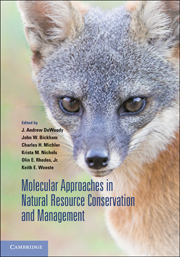Book contents
- Frontmatter
- Contents
- Contributors
- Preface
- 1 Biodiversity discovery and its importance to conservation
- 2 Gene flow, biodiversity, and genetically modified crops: Weedy rice in Thailand
- 3 A community and ecosystem genetics approach to conservation biology and management
- 4 Vertebrate sex-determining genes and their potential utility in conservation, with particular emphasis on fishes
- 5 Historical and contemporary dynamics of adaptive differentiation in European oaks
- 6 Association genetics, population genomics, and conservation: Revealing the genes underlying adaptation in natural populations of plants and animals
- 7 Hybridization in threatened and endangered animal taxa: Implications for conservation and management of biodiversity
- 8 Pollen and seed movement in disturbed tropical landscapes
- 9 Implications of landscape alteration for the conservation of genetic diversity of endangered species
- 10 Integrating evolutionary considerations into recovery planning for Pacific salmon
- 11 Using molecular methods to improve the genetic management of captive breeding programs for threatened species
- 12 Wildlife reintroductions: The conceptual development and application of theory
- 13 Evolutionary toxicology
- Index
- Plates
- References
12 - Wildlife reintroductions: The conceptual development and application of theory
Published online by Cambridge University Press: 05 July 2014
- Frontmatter
- Contents
- Contributors
- Preface
- 1 Biodiversity discovery and its importance to conservation
- 2 Gene flow, biodiversity, and genetically modified crops: Weedy rice in Thailand
- 3 A community and ecosystem genetics approach to conservation biology and management
- 4 Vertebrate sex-determining genes and their potential utility in conservation, with particular emphasis on fishes
- 5 Historical and contemporary dynamics of adaptive differentiation in European oaks
- 6 Association genetics, population genomics, and conservation: Revealing the genes underlying adaptation in natural populations of plants and animals
- 7 Hybridization in threatened and endangered animal taxa: Implications for conservation and management of biodiversity
- 8 Pollen and seed movement in disturbed tropical landscapes
- 9 Implications of landscape alteration for the conservation of genetic diversity of endangered species
- 10 Integrating evolutionary considerations into recovery planning for Pacific salmon
- 11 Using molecular methods to improve the genetic management of captive breeding programs for threatened species
- 12 Wildlife reintroductions: The conceptual development and application of theory
- 13 Evolutionary toxicology
- Index
- Plates
- References
Summary
Throughout the latter part of the nineteenth century and early portion of the twentieth century, there were widespread declines in wildlife species in North America due to unregulated harvest for commercial, regulatory, and private uses as well as dramatic changes in land-use practices (Moulton & Sanderson 1999). Despite recognition of the grave situation facing many of the most popular and common wildlife species, resulting in the initiation of continent-wide conservation and management programs for both game and nongame species, many of these species were critically imperiled by the time such programs were initiated (Mackie 2000). The history of wildlife management and conservation programs in the United States is intrinsically tied to this point in time, in that many of the practices and values that are in existence today stem from the recognition that wildlife resources are not inexhaustible and that active management and protection efforts must be implemented to offset the negative impacts that our species exerts on natural resources.
One of the most effective and widely used tools employed by wildlife management and conservation organizations to recover and redistribute wildlife species within suitable habitats is the practice of species translocation (International Union for Conservation of Nature [IUCN] 1987). Indeed, species-translocation programs targeted at reintroducing or introducing wildlife species to areas of suitable or reclaimed habitat were used extensively in attempts to recover decimated species across North America beginning in the early portion of the twentieth century (Griffith et al. 1989; Fischer & Lindenmayer 2000). Early in the development of these translocation programs, most emphasis was placed on elucidating the ecology of species targeted for recovery; locating potential source populations from which to draw individuals for translocation; identifying areas of habitat suitable for population establishment; and developing viable capture, handling, and veterinary protocols for species targeted for translocation (IUCN 1998). As the logistical considerations of translocation have been optimized for growing numbers of species, the utilization of this tool has grown to encompass not only species recovery and reintroduction programs but also numerous additional applications, including population supplementation, population expansion, and nuisance-animal management (Griffith et al. 1989; Linnell et al. 1997).
- Type
- Chapter
- Information
- Publisher: Cambridge University PressPrint publication year: 2010
References
- 8
- Cited by

